|

SATURDAY 26-6-2010
We had arrived at the border by 8:30 in the
morning. While the check out from Bolivia was
fast the Peru immigration man kept us
waiting. He stamped first two busloads of
tourists in, which took one hour. This highly
skilled professional, had problems with my
passport, As we were aware, Bruneians do not
need a visa, but he did not know. So
gesticulating that he will phone Lima
headquarters, we waited another half hour. Meantime the boss showed up for work,
usually one hour late because he is the
boss.
That was good news, as bosses are
clever and intelligent, is it not? Otherwise
they would not be leaders." My one is an
idiot" you
may argue now and perhaps it is
true, but this one went straight to the
tabletop of the counter. Under a glass
panel was a list of
countries and his
pointing finger searched and found with my
help "Brunei Darussalam - no visa" .
The chop was in my passport,
90 days to
stay.
For a while we traveled along the shores of
the Titicaca lake, the nearby hills still
dry and barren. However as farther we came
north
the rain seems to set in more frequently as forests appeared. It was night, when we
arrived in Cusco, greeted with a bus
registration
number in front of us 1117, the lucky number which followed me
through life and on our journey.


the first replanted forest patches
1117 shows up throughout my life
Searching for the train station "San Pedro",
we came into the old town where we checked
into a hotel for
a good price of US$ 30.-
/night. "That is
Cusco" said Harun looking around in the
plaza, surrounded by old Spanish churches.
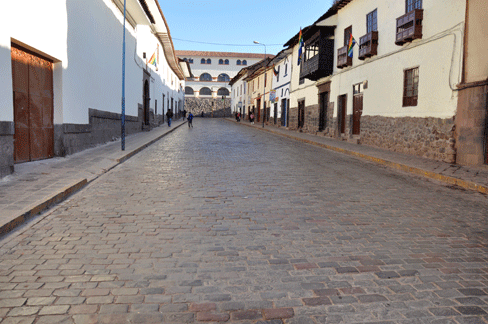
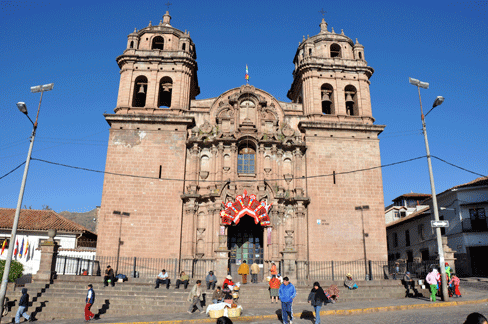
plaster laid out street in the morning
hours
the San Pedro church
There is a joke around St
Pedro, the door opener in heaven according
to Christianity. One day a preacher and a
Peruvian bus driver
stood at the entrance door demanding entrance to heaven. St. Pedro
open the gate look at the two and invited
the bus driver first.
Just before the door closed, the priest lamented: "Holy Pedro, I
have served the church all my life, ever
Sunday we held mass and
prayed, so, how come the bus driver can go in first?
"I know all this" said Pedro. But with the bus driver, when he was
driving, the passengers prayed all the
time ."
Tomorrow we will be passengers in a tourist bus.
Here the Incas history begun as a tribe sometimes in the 13th century, to form
small city states and begun there expansion
under the
paramount leader Pachacuti Cusi
Yupanqui and his son. Their control reached
what is today Peru and Ecuador. Pachacuti is
said to
have build Machu Picchu either as a
summer retreat, but no one is sure.
We stop here for two days, to explore the
remains of the Inca kingdom, what was
not stolen, robbed, or destroyed in the
course of
time, beginning with Francisco
Pizarro, in the name of the Spanish crown,
particularly the Spanish queen which signed
a degree
in 1529 in this effect.
The Incas had just defeated Pinto and
crushed his resistance to the rule of King
Attawallpas, dancing to the tune of a drum,
made
from Tinos skin, when a messenger
arrived in Cajamarca informing him, that
white men with beard on strange animals
(horses) had
just landed in Tubes. Attawallpas face was stone. He knew what is
going to happen and send the message over
his kingdom. With
the fire telegraphy from
mountain to mountain such messages could
reach a distance of 1000 km within hours.
But it was not that easy to land on Peru's
shores, as a member, Gaspar de Carvajal,
reported; 'the men searched along the
beach,
half naked and almost crazy, for
mussels and crabs."
But one day they reach Cusco, removed and
kill Atalwallpa as Inca king, and put
instead his brother Wasar on the throne.
SUNDAY 27-6-2010
We were on route to the first of several
archeological sites.
Pisac was the first to visit. It
overlooks the Urubamba, or the sacred valley as it is known.
High up on the slopes the buildings are
nesting with a view over terrace fields and
the valley deep below.
It seemed to have a multipurpose
construction, militarily (to defend the
southern entrance to the sacred valley),
agriculture and
religious.
In the cemetery, Graves on the upper
area have been opened and destroyed either
by the Spaniards in search of gold or
other tomb robbers. The temple of the sun holds
the Inihuatana the sun stone, which has been
broken and vandalized over time,
beginning with the Spanish invaders.
The foundation of
Pisac
is not clear, somewhere around 1410 ad. As
with many others, Pisac was dismantled by
Pizarro in 1530.
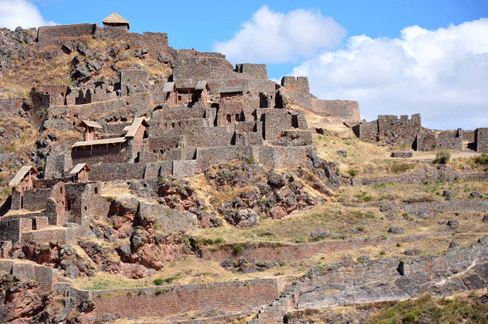
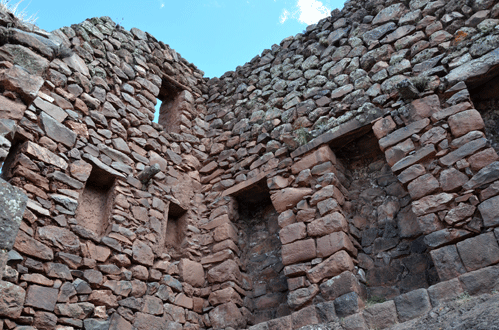
The Qualla
Qasa residential quarters
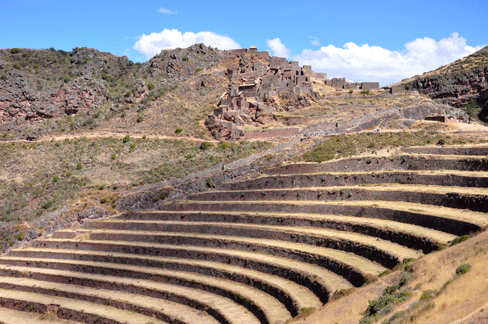

Agriculture
Terraces under the quarters
View to the valley below

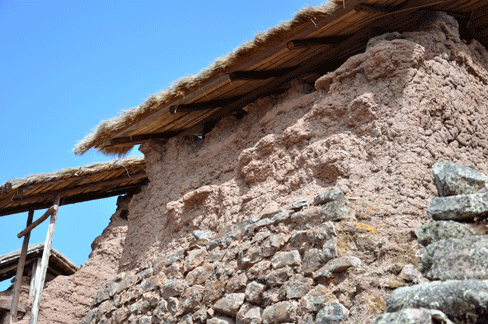
Granite, perfectly fitting
rough construction; a storage building?
Some construction in red granite, were
masterly mansion works, others had the
base made from stone and the upper part in
compacted earth.
The Andean area is one of
the world’s great centers of plant
domestication. Its inhabitants had lived
chiefly by their agricultural labors.
Plants
cultivated in the Andes probably would
exceed 35 species, most of them
domesticated. But only six to eight species are
planted above 3300 m, mainly potatoes,
but also grain and leaves which were boiled
like spinach.
As the Andean valleys are deep and narrow the Incas solved this
problem by terracing using stone irrigation
channels. The Inca
government set and
marked the boundaries, as taxation was based
on them. There was no place for cheaters. It
was a crime to move
them. The second offence
was punishable by death.
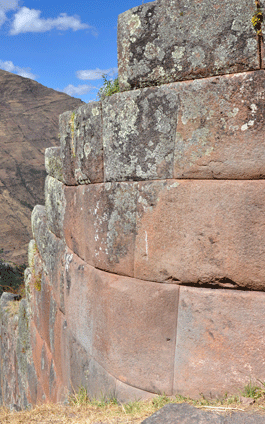

sun temple
curved agriculture terraces
The Incas believed that many rocks,
mountains or locations were sacred to gods
or earth spirits. The agriculture terraces
below
Pisac are curved like birds wings.
Today, the locals, many descendants of the Incas,
have lost their past and are not yet in the
presence. Left to sell produce to tourists,
fine textiles made from Llama
wool.
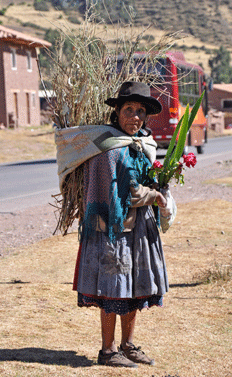
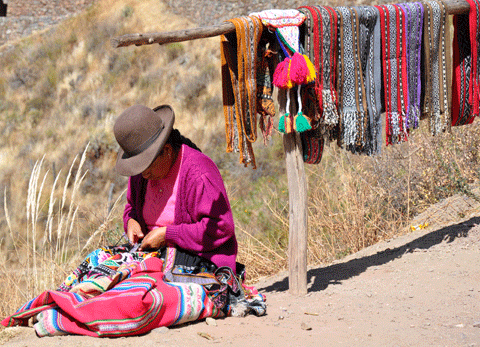
hill tribes of the sacred valley
textile waving on the roadside and waiting
for tourist money
Or sit in their traditional dress spinning
Alpaca or Llama wool as done 1000 years ago,
waiting politely, that someone may drop a
few
coins after the photo session. A
meager life indeed. But upholding inheritance
brings tourist dollars.

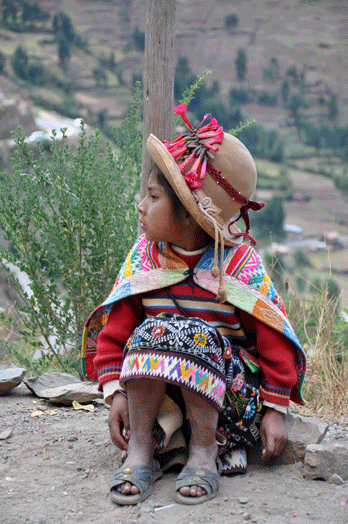
Mama with her three siblings; spinning wool for
tourist dollars " Look!
Anything going on there?"
Yes indeed. There was news in the
Pisac town.
A tourist had ask for the hand of Rawanki
the lady selling strings everyday near the
market.
She was not that sure; However, when he turned his charm on and offered a dowry of 5 Llamas, a pig and 12 chicken,
she consented
to look up to him.
But first, what we cannot deny, any elderly groom
out of the flat lands had up here to
undergo a marriage test.
To proof, if
he, in his age is still able to do the "GSST
GSST" in these Andean heights, without going
out of breath in 10 seconds.
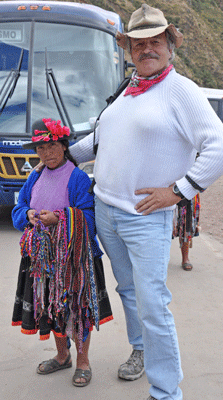
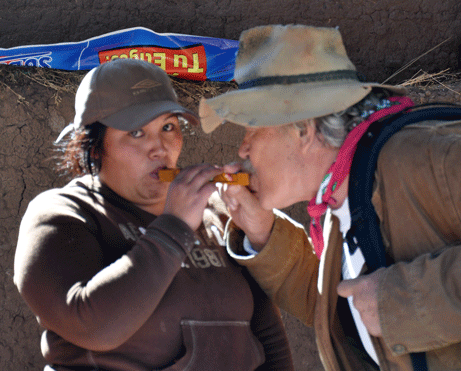
Full of hope "Rawanki and
the tourist..."
the failed test
This test was a double blow on an Inca flute.
While Rawanki's daughter in her maiden years
blew at one site, he had to counter the air
pressure. Lets face it, he failed.
Holding his mouth tightly, heir air pressure went down into the belly and through his
intestines, out of him again, with some
unpleasant noise. (What a shameful moment that was).
"Where is the toilet here?" he asked.
Although no one spoke his language, a certain scent in the air
indicated the urgency. Slowly with
stiff legs he walked towards the
"Bano publico", the market
toilet. From nowhere three dogs had appeared
and run with him, sniffing.
The "Inca maiden marriage" remained, due to
his miserable fitness, a "Flat Lander"
dream.
Our next stop was high up at 4000 m a
village, Chinchero, where a group of
highlanders demonstrated the coloring and
waving of
Llama wool as done since ancient
times, using only natural ingredients.
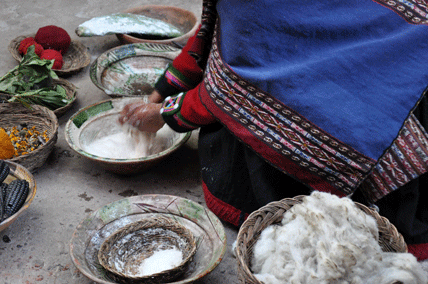
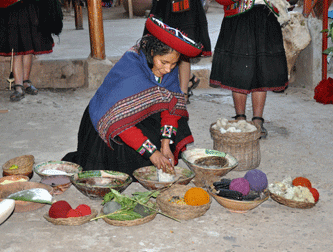
washing the wool first
in front the coloring plants to be used
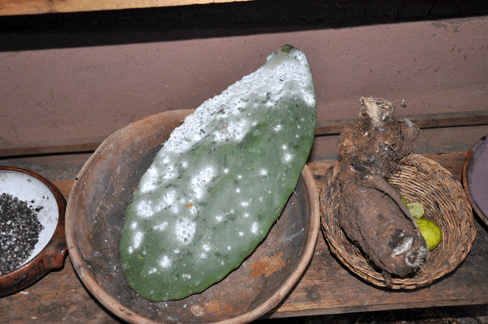
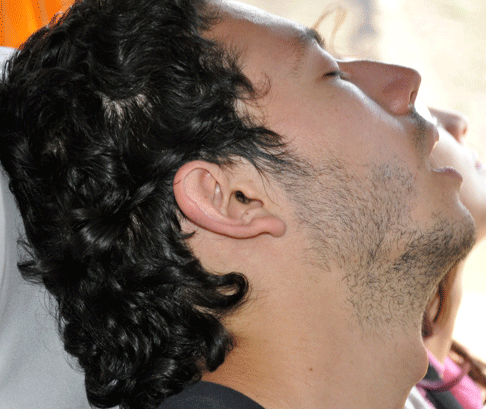
the white cactus parasite gives red lipstick color
and an onlooker
While it seems, the demonstration pleased
the general audience, this younger couple
had likely drunk Coca tea
for extra night
energy. He had not much
interest on the colors of textile, that can
be seen.
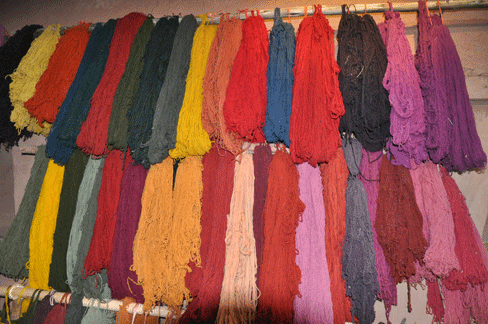
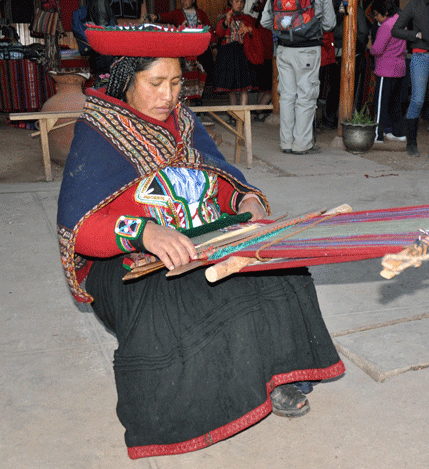
fine colors are achieved woven to dresses and carpet
From there, we were
invited for lunch somewhere." We must eat"
said the tour guide when he saw Norhayati holding a vegetarian
"Entree"; she just stole from the
guanaco.
The group went into an
original Inca restaurant.
From far one could
hear an Inca band playing, which
turned out to be one man. Remarkable what
music he could produce.
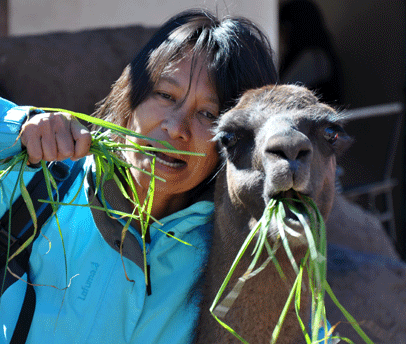
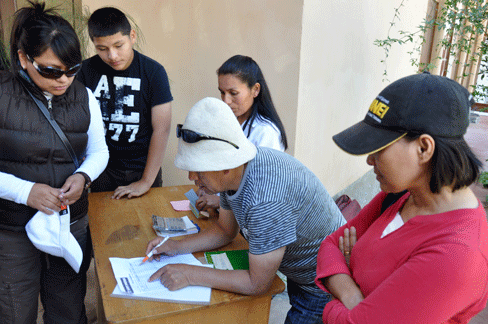
"We must go lunch now" said the guide,
seeing Yati
but first: "Are you guys on the feeding
list?"

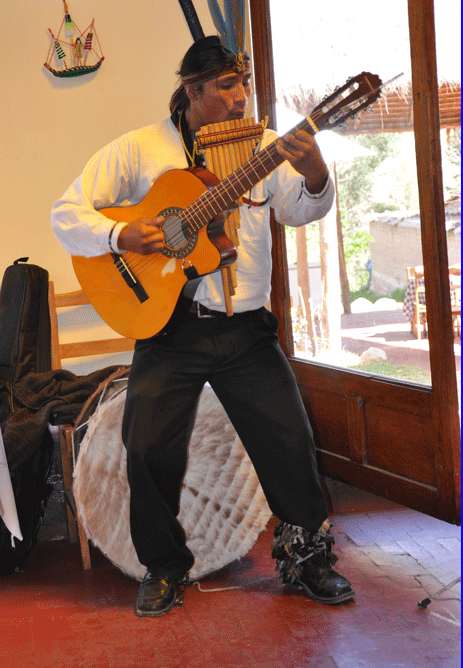
buffet frenzy
the "Inca orchestra"
And so, enjoying the "band", our tourist
group fell over the free buffet. Harun had
twelve "kicky mikki, one piece meet" chicken kebab,
before
the observing servant removed forcefully his
plate and started to clean the tablecloth.
Sleepy and full, everyone was carried to the
next Inca destination.
Ollantaytambo
This is the only place where the Incas
defeated the conquistadores in battle, as
the Inca leader Manco Inca, flooded the
valley below
the fortress, causing much
trouble to the Spaniards. They were driven
back to Cusco.
The architecture features some of the
largest stones. The Spanish described
Ollantaytambo as a fortress.

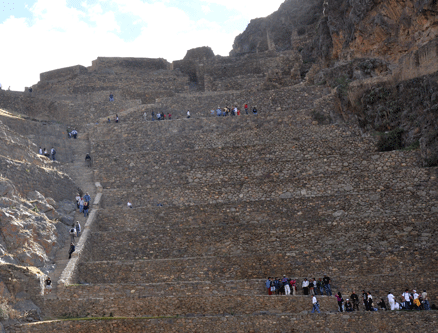
ruins at
the mountain slope Pumatallis terraces and tourists
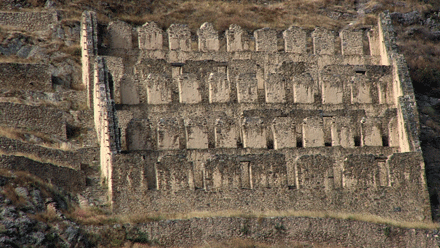
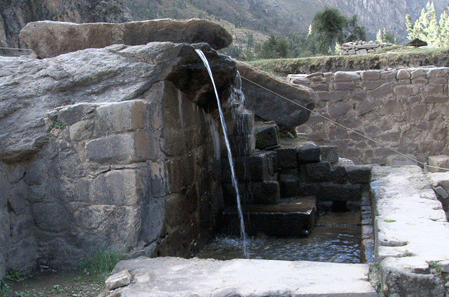
on the opposite slope Inca
storehouses
the "bath of the princess"
We met this Inca girl together with her
mother on the market, waiting again for
tourist money, as they come by the
hundreds,
every day. How giving they are, is written in the stars.
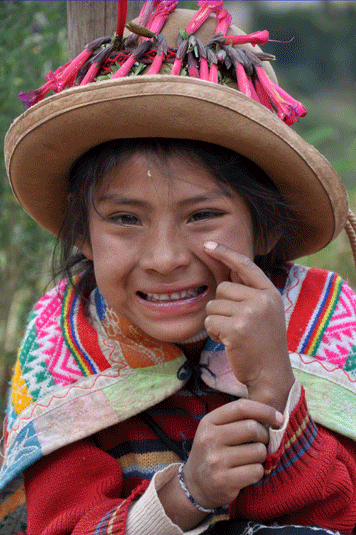
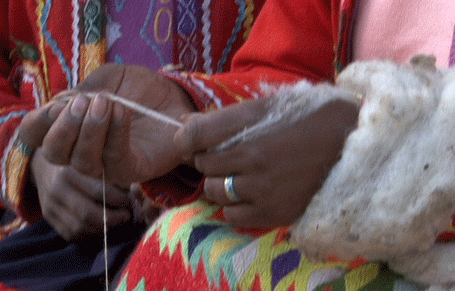
on
the kids hut "Qantu" the holy flower
waving Inca hands
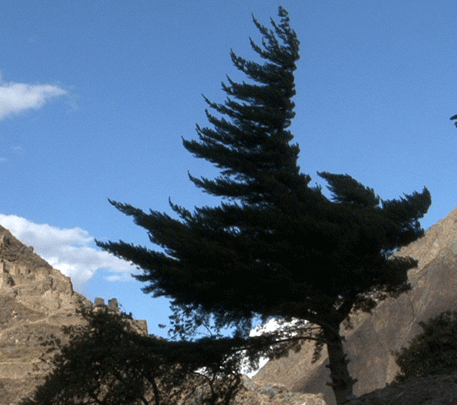
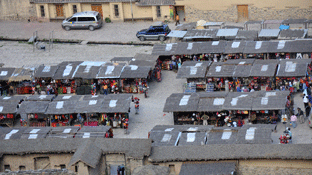
...always wind from one direction
the market stalls filled with tourist
souvenirs
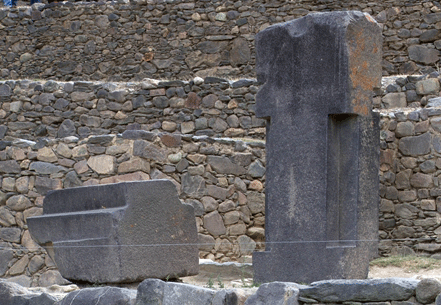
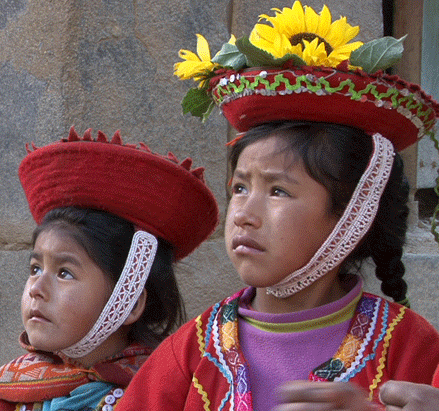
fine mason works; polished granite. Energy
stones?
two Inca descendant
We the "Flat Lander" seeing all
this and thinking, ask
the question:
"What future will these kids
have?".
The times to fight for mineral on
our planet has arrived.
Peru had never had an industrial
revolution. Many south American countries are sleeping giants, giants in resources.
The Anglo-American mining profiteers press
on the doors. "I have the money, you take
the shovel! Together we make you and your
country rich." A lie?
We returned to our hotel by evening.
Tomorrow I will travel to Machu Picchu;
alone. Harun remain back, as the prices are
exorbitant.
MONDAY 28-6-2010 ,
.
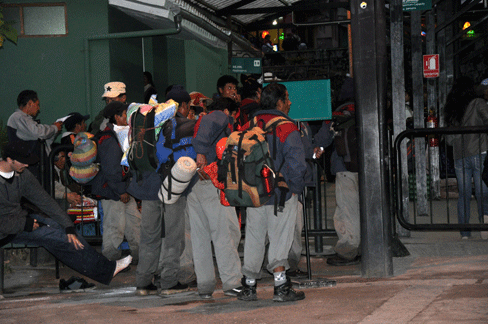
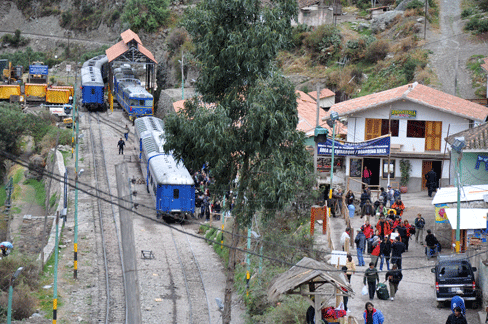
waiting for the train
on route
In a transport combination of bus-train bus, with lots of back
packers, I reached as one of 2500 tourists
which arrive daily, around
1:00 pm the ruins
of Machu Picchu.
Although Picho was known already in 1568 to
the monks of a gigantic hacienda operated
north of Ollantaytambo, Yet is was only
from
1912 to 1915 that the whole complex was
opened and exposed by an American,
Hiram Birmingham. He insisted that the ruins
were raided before him already and no gold
was found. However he still looted according
to another archeologist, 220 objects in
silver
bronze and copper, and secretly
shipped them to USA. The treasure in the Yale
university is claimed back now by the
Peruvian
government,
What he still found, are 150 mummies of
which 105
were female.
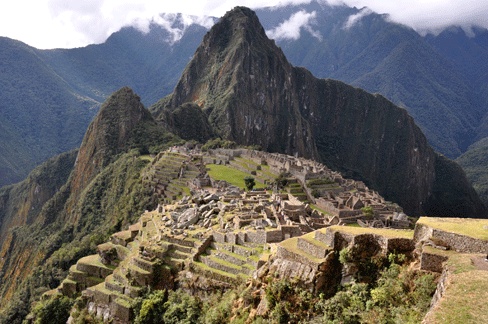
The complex in 2400 m
Machu Picchu was build around 1400 AD, but abandoned as an official
site for Inca rulers hundred years later.
She is often referred
as the "Lost city of the Inkas". Today she is an important tourist
attraction.

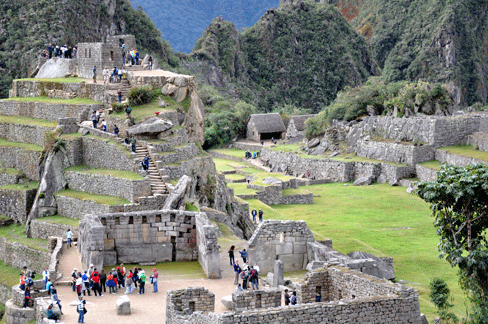
Machu Picchu main square royal enclosures
But what was this town made from granite? A
citadel? a temple? a royal refuge? Or all
together? We see here a palace,
temple,
living quarters, storage facilities,
agriculture terraces with an
engineered irrigation system yielding 3
harvests a year, which could
feed 1000
inhabitants.
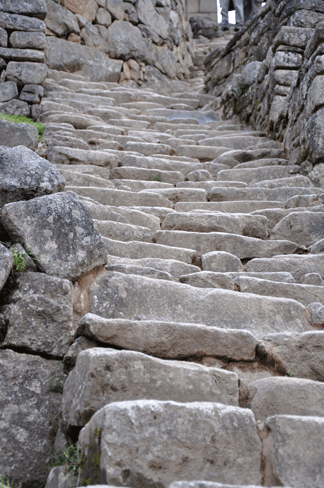
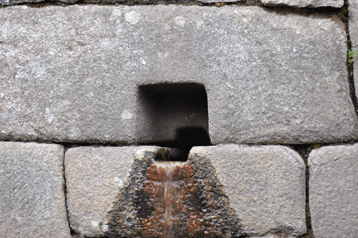
stairs to the next level
irrigation channel and water supply
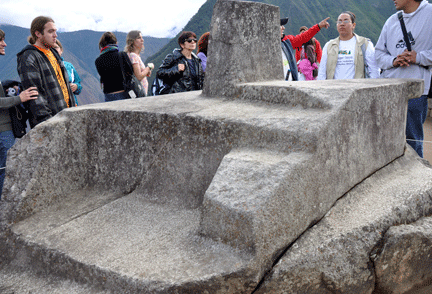
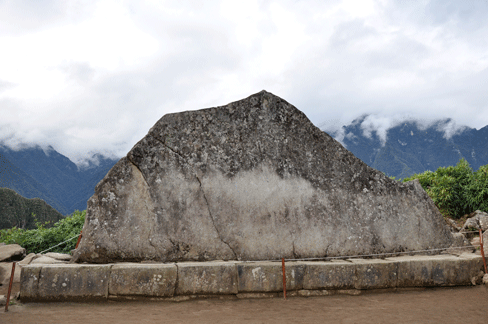
Intiwatana rock, "where the sun
is tied to..." ceremonial rock
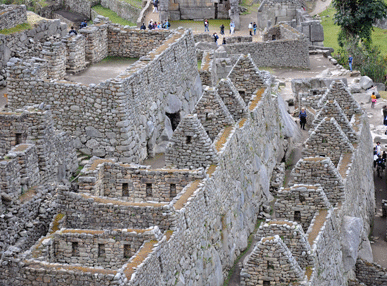

Craftsmen sector
Astronomical observatory
The buildings are in general
square shaped and trapezoid openings for
windows and doors.
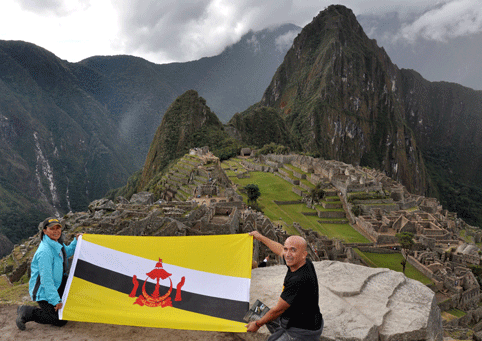
A historical moment; Our flag on Machu
Picchu
How did I manage all the photos without too many
tourists, is itself a miracle. The day was
gone in no time, we were called by the
whistle of our guide to return to the bus for the journey
into the Inca valley.
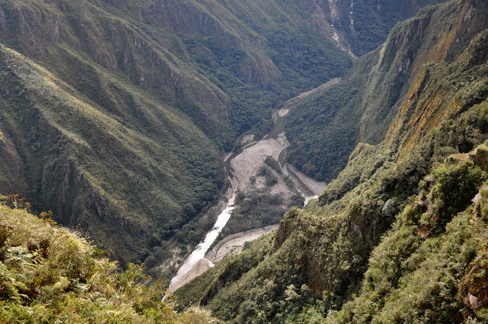
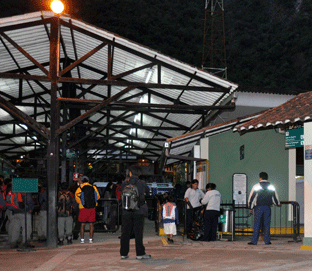
A last look down the valley to the Rio Urubamba and then I went
the stairs down where the busses towards the train station were
waiting. On the way back to Cusco I thought of the miserable sanitation, no
flowing water in the toilets, the impact
this vast tourism
spectacle will have over time on the environment.
The entrance fee is about US$ 40.-. 2500 people went with me up
this Monday. The authorities cashed US$
100.000.-.
That is allot for one day.
With the income of 10 day, one million US$, the infrastructure can
be upgraded to European standards.
And the flow of tourists regulated. (Where is the money going too?)
When sitting in the train I slept away dreaming; and it seemed to me to
hear words of a Inca shaman who
thundered:
" You white man have murdered our children with smallpox and
measles; you stole our gold, your weapons
killed our men.
Now we are only a few. But we are strong spiritually. By our
powers, we force you to come, to see the
ruins of our glory.
Feel remorse when you trample over our sacred sites; You are cursed
to come and you will, until such time, when the sun
returns to
the rock on sun island, from where she rose once in the time of lore.
I arrived at 11:30pm at the hotel, Harun was
waiting in the foyer.
TUESDAY 29-6-2010
We returned today with JAMBO to Urubamba valley. Crawling up the
mountain over high plains in almost 4000 m,
where agriculture is
practiced; hard labor for beast and man.
As it is autumn now, the harvest, potato's, grain and barley is in.
Fields are plowed again before the next
raining season.
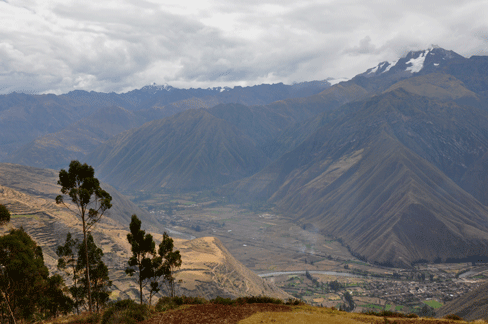
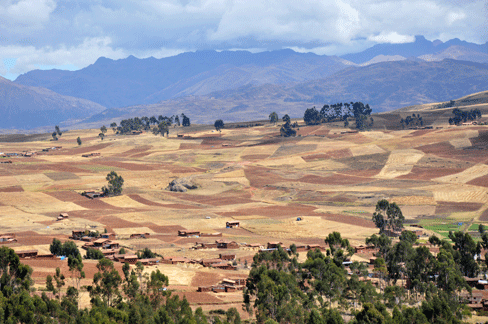
Down in the valley, the town Urubamba
highland farming in 3700 m
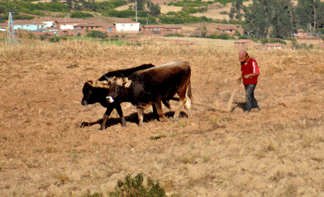

plowing; one furrow at a time
following the farmer
The girl following him to search for turned up potatoes,
eventual not seen at the harvest. At a
distance a boy bringing home straw
of his filed, as fodder perhaps or as mixing material to mudstones
for an extension of their little house.
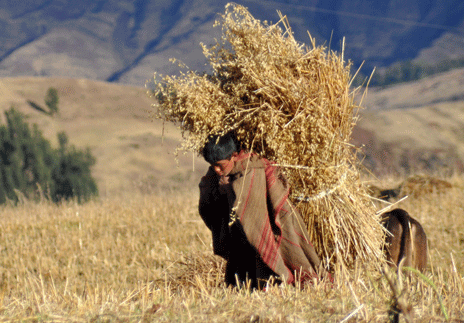
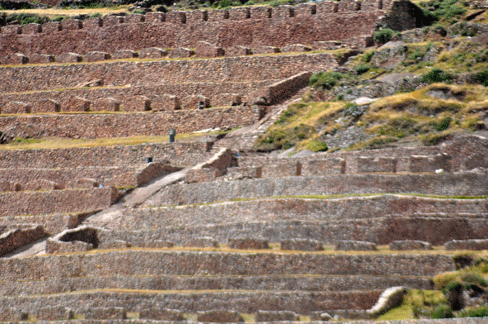
heading home with heavy load
Inca
storage facilities
Up here where the tourist busses frequently pass on their way to
Inca sites, villagers have put up stands to
add a few Peruvian sols
to their living. Mamas with their siblings have spread their wares,
wait out the whole day, maybe a bus will
stop, the driver earning
some commission.
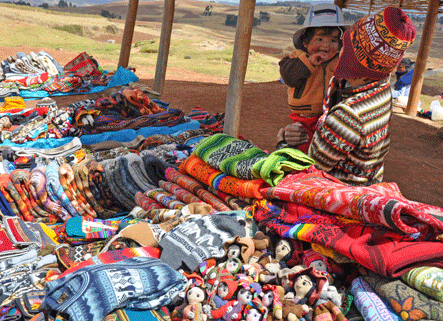
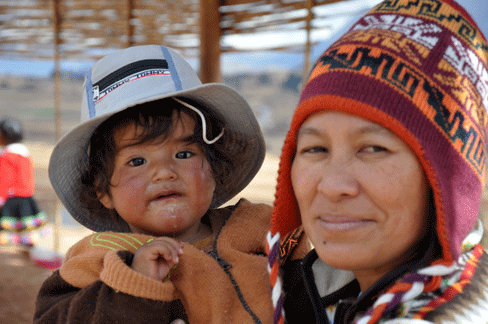
Plastic Acryl or Llama wool, the buyers
choice
Mama and kid (she looks somehow familiar)
Our journey continued up in the highlands, JAMBO
was "smoking" The air is too thin and the
mixture ratio air fuel is no more correct.
But we went on, looking at the way the locals come to
terms with their live.
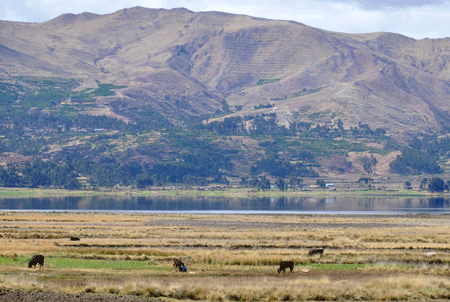
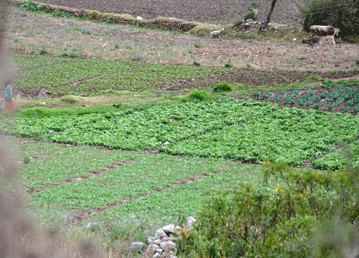
here, some cows feeding on straw
there, a veggie garden hand irrigated by a
highland maiden

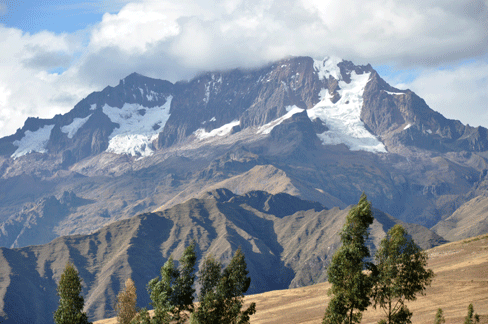
a prayer for will and strength
Up here in 3900 m, we saw this "Inca" with raised hands
facing the sacred mountain Chicon. He
was in prayer.
We had stopped. Vague his murmur reached our ears. He prayed for a
beloved one; a prayer of hope and happiness.
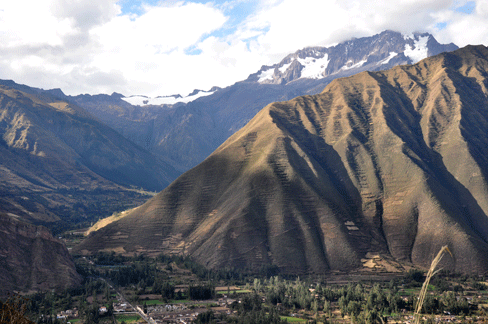
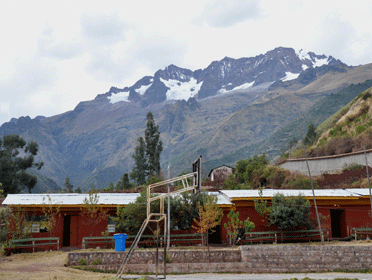
The Chicon valley towards the mountain
a school on the foothills of Chicon
Our coming to Urubamba had a
special purpose. Up in the Chicon valley
just under the sacred mountain Chicon,
caring and love, the
attributes of humanity, made a project for children, a school and
dormitory for abandoned little Peruvians.
A place, where now about 200 kids learn. They get nourishment for
thoughts in the classroom and before going
home, food for their
little bellies too. A free meal, at least once a day. Harun was
moved by this kindness and said. "That is
Schulspeisung"
Just as it was back once in Germany and Austria, when US and British murder bomber
fleets, burned out our cities,
in an attempt
to perish Germany and an act of "humanity". Up till today, these crimes are
unpunished."
He looked angry confronted with
these thoughts.
We just arrived at the kids best time of the day. Classes are over
and a meal came along.
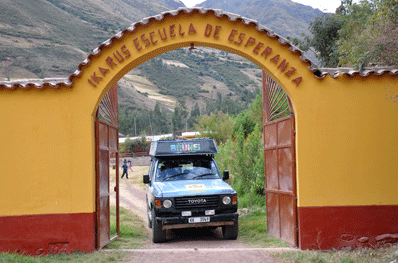
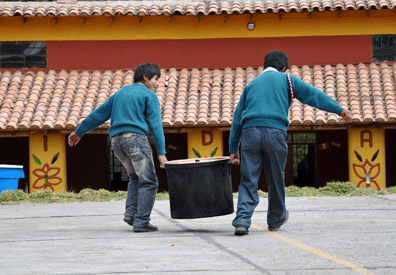
Entrance to the school compound;
here comes the free meal
Ikarus Tours, initiator and sponsor; We, DDL Tours, work with
them over 10 years in Eco tourism
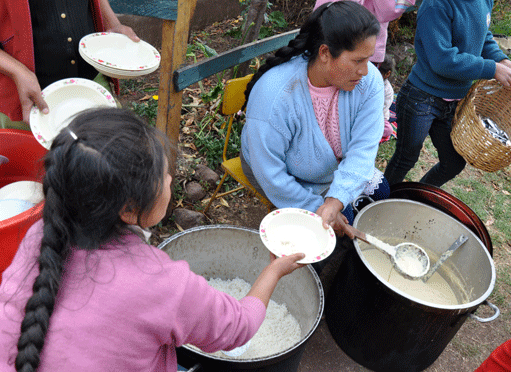
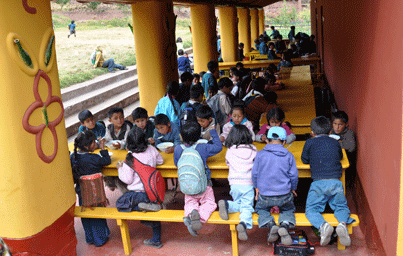
full bowls
and happy moments
Further up the valley
there is a home for kids out of broken
families. These young "disposed ones"
have a new home.
About 150 children live here. Would they be otherwise on
streets in Cusco?
Here is a future, here are humans who care for them.
Besides professionals, often volunteers out of Germany and
other countries.


Honorable reader; don't you want to help?
The orphan homes for 150 kids

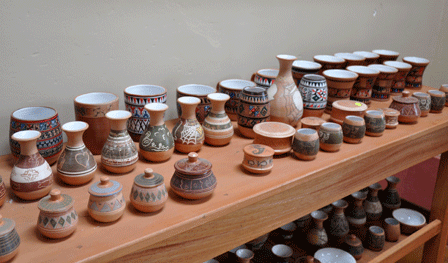
Dormitory
impressive ceramic products made by
the kids
In the foyer, a paining of Pancha Mama, the earth goodness. She has
spread her arms, holding in each hand a
child.
Here she is active through kind hearths in foreign lands. Such an
institution cost money. Allot of money.
Additional buildings are in planning or even execution stage.
We have seen the efforts resulting in smiling, happy children, and
therefore throw into your soul the question,
" How much are you going to donate?
Their account is in Germany.
Name: 'Herzen fuer eine neue Welt' . Bank: Deutsch Bank
Koenigstein. Account no 4722237 BLZ 00 700
24 Germany.

artists image of " PACHAMAMA "
It is you, honorable reader who could support this project too. Or
decide to waste on useless items, what is
need here.
WEDNESDAY 30-6-2010
We have refrained of showing you Cusco's Spanish achievements and
are today out of town on route to Nazca of
which you have
surely heard about. A place where extraterrestrials were active
say's one party, the other laments:, "ah
just locals made these lines".
We will see and judge ourselves. But first Harun's pride had to be
repaired as "one ear" was hanging down
already. "10 soles" was
agreed as repair price, as we brought the material and the glue.
When he had finished after 20 minutes he
asked for 50 soles. Poor
him. He must have frantically thought, how could he jack up the
price. Harun only said two words: "No,
Police", and quickly he settled
on the agreed price. We gave him 5 soles on top.
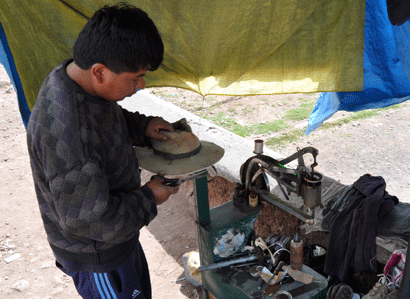
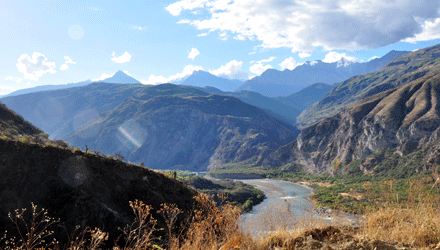
Traveling
until the evening through a spectacular
landscape, the land raising up to 4000 m.
The road was fine and not much traffic.


a
village on the only flat area around
barren mountains up to 5000 m high
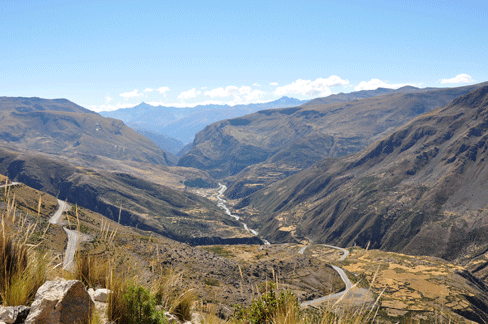

climbing the mountain pass up
JAMBO in the National park
Driving down the mountain again on the other side, it was already
night. There was a signboard "NATIONAL
PARK".
We curved in and stopped on the parking area. No one around, except
wild dogs. Some stones held them at bay, but
next morning
the wet tire marks proofed that some of them sneaked back while we
were sleeping.
THURSDAY 1-7-2010
By 7:00 am we were at the road again, In no time we were
climbing up to another mountain pass over
4000m.
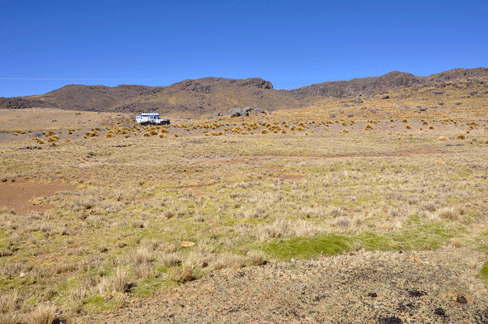
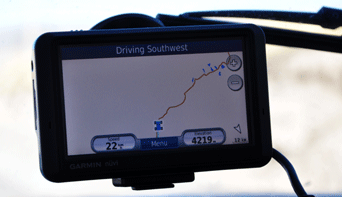
Our GPS showed 4219m,when we
noticed two cones on the right slope and
went to investigate. There was no marks on
them.
Only birds had made a few holes to nest.
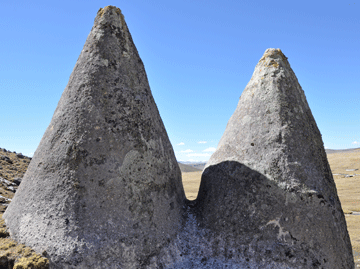
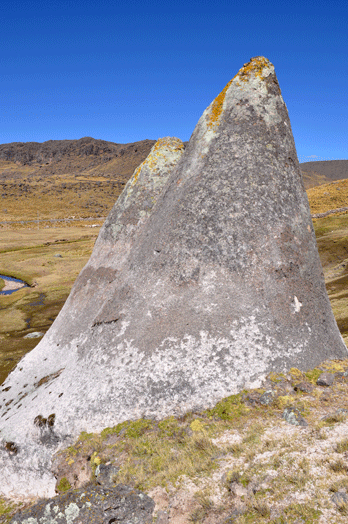
We estimated the height to about 4 m and the
base diameter 3 m per cone.
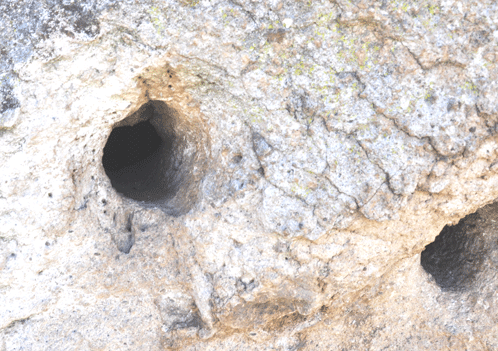
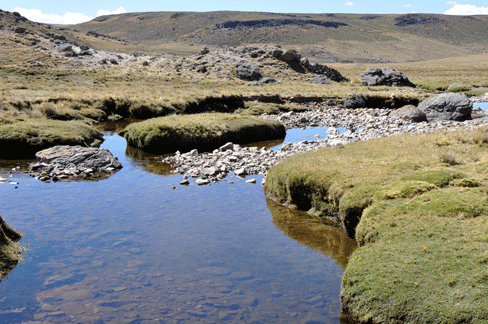
Holes made by birds?
Even in these heights there is small stream
flowing
And down again into another valley, and into a village of some
strange customs. The three wheel local taxi
looked like a mobile
grasshopper head and that lorry driver saved on the cabin and body,
and purchased a helmet instead. Maybe he
liked the breeze. No
number plates either. But this matters little in this part of the
Andes.
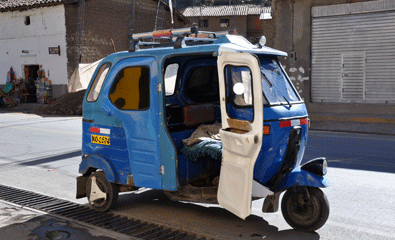
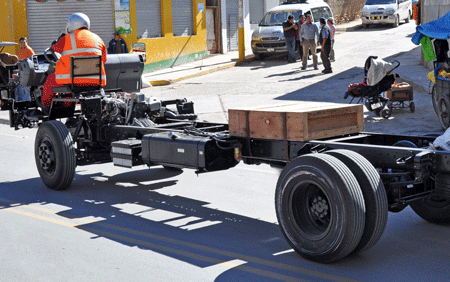
The grasshopper taxi
a ride in the wind
There was this bus stop restaurants, they lured the customers with
fresh chicken. We had no breakfast and
hungry now, decided to
get something to eat.
The waitress, a young girl did not speak Spanish. How to tell her
that we wanted to eat? Harun explained to
the girl. "Porvavor;" he
pointed to the chicken, flapped his elbows like wings and show with
one hand a round form, meaning egg. She did
not get it. One
more time, but with a loud "Kikerikiiii". Nothing. No
understanding. Finally he showed up on the
prison slot between the kitchen and
restaurant, and tried to converse with the cook direct . The result
you see on the table.
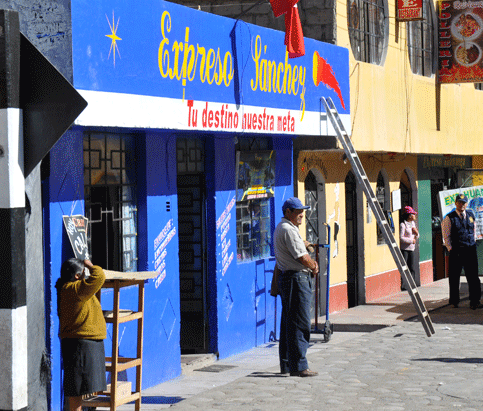
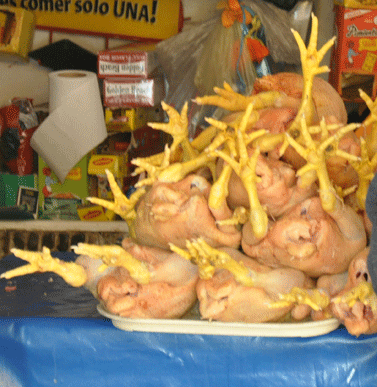
The restaurant
promising feast
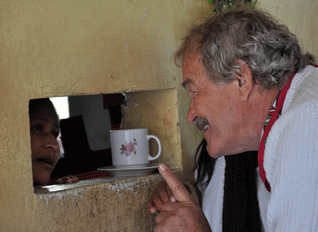

"Porvavor some food;
eggs, omelet anything!"
"something for inside here!"
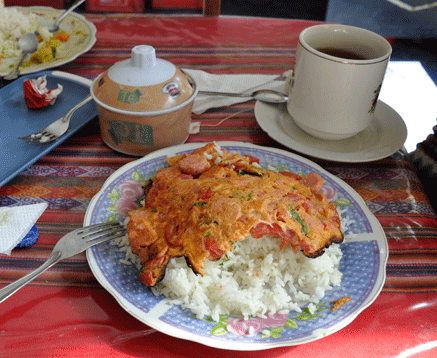
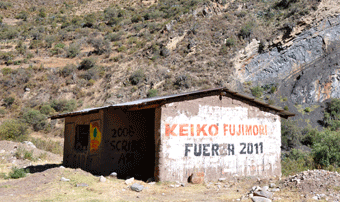
This was what we got. An -uneatable omelet (at least for our
taste). Inside some veggie, a cut down hot
dog, a red colored egg in
some type of potato flour, burned at the edges on a hip of rice.
Even Keiko Fujimori the run away president
contesting again for 2011
would, by all love for this country, have declined this " this meal
of the Andes".
Hungry we went on again up the
road onto high planes. It was peaceful,
Alpaca were grazing next to the road. You
notice the thick
wool. The landscape had leveled out, we drove now in 4200m
and came to a small crater lake where we
stopped to cook a meal.
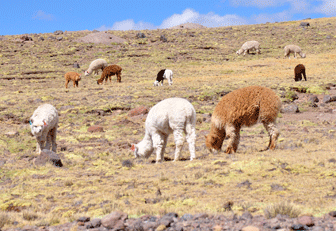
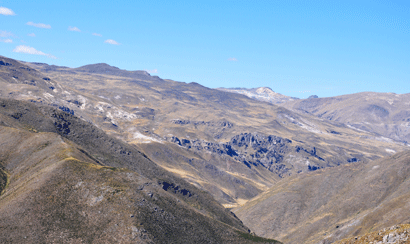
A herd Alpacas grazing nearby
Looking back down into a valley

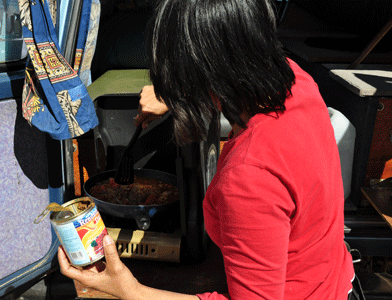
Believe me dear reader, that was "spaghetti rendang" at the highest
place I have ever cooked. Even the boiled
noodles weresomehow
soft. As you knew the water boils already at 80 degree centigrade
up here.
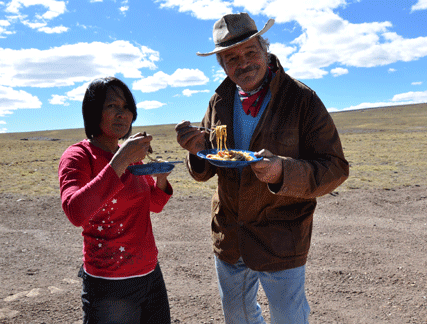
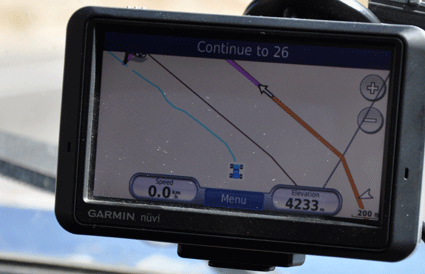
a good meal after all
the height proof
The lake was perfectly round. Perhaps from a meteoric impact A few
ducks swam around quarreling,
otherwise it was still.
After the mountain spaghetti, not much further, the road climbed
again in serpentines up. Over the rim was
the highest point of our
travel. 4.560 m.

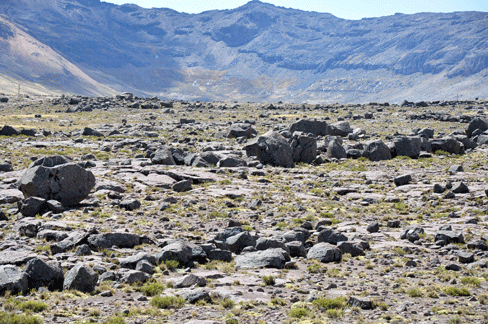
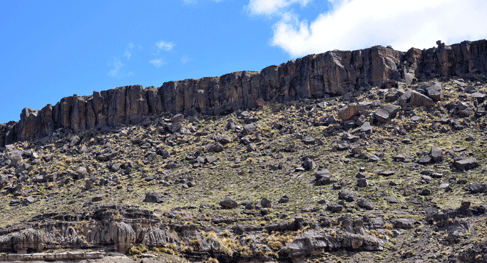

Here rocks prevail. Hardly any vegetation, therefore no wildlife at
all. For another 10 km or so, the land had
leveled out, holding the
height, then the road wound down again like a lazy snake lying on
the mountain side. In 3500 m, we met these
mountainfolk, begging
on the roadside.
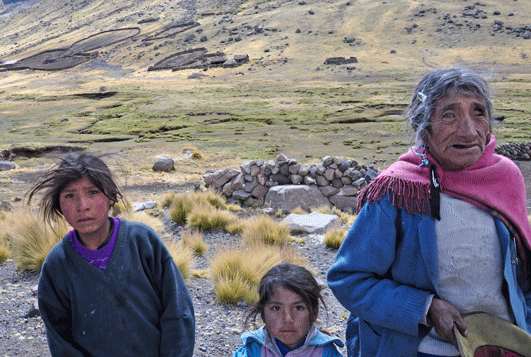
That is how we met them
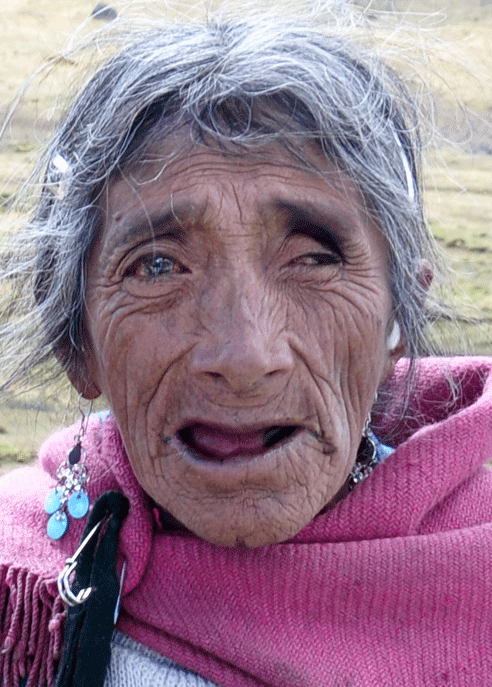
Grandma; what life did she had?
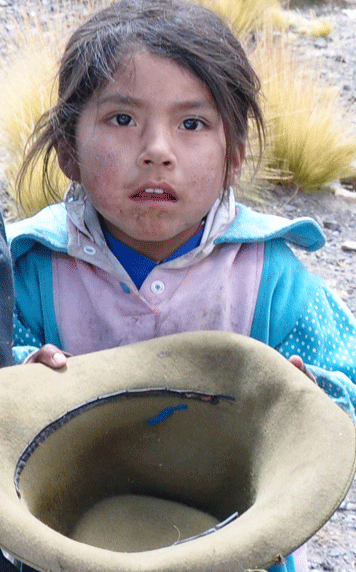
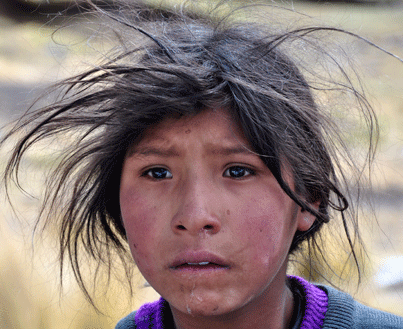
Honorable reader, look at these
faces. Look again! A life of hardship in the
face of "one eye grandma".
See the smallest holding the hut. The picture says "give please!" .
And the girl with the wild hair, Is she in
panic? Is she full of fear?
What has happen to them?
We gave what we had to eat and some coins too. But sitting here in
Nazca writing the web site, we feel like
going back and find out
more and help.
The heart burns, looking at them.
Not much later we passed more of these cones, standing on a slope.
That was not manmade, it was the soft
material which due to
wind and eventually rain, undergoes a natural erosion process.
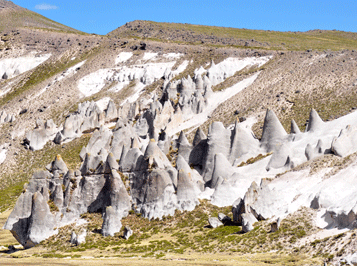
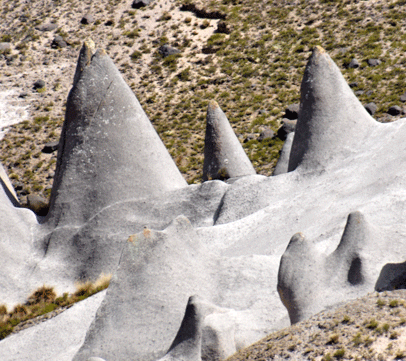
Like in Cappadocia Turkey
Down went the road, and no more up. It seems we are leaving the
mountains. Sometimes kraals are seen made
from stone, to where
the alpacas return in the evening.
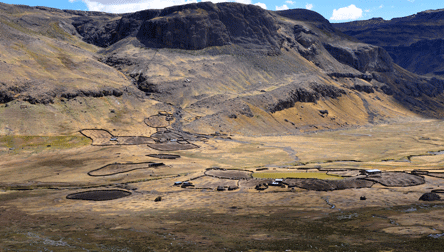
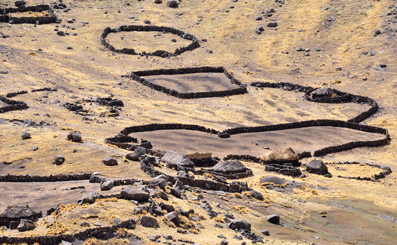
The whole way down to Nazca we had to
drive very, very carefully, rather slowly
than fast. We thought off these poor people
up there.
After nightfall we reached the town which became famous because of
lines and figures in the desert, once
created, when the Nazca
culture was dominant, today they are long gone. We are keen to
explore them.
FRIDAY 2-7-2010
Together with two Peruvians, we climbed into a small plane
after paying US$ 60.- for a 15 minutes
curving over the figures.
The Peruvian lady had a cross in the hand and one around the neck;
she was praying between the photos. With so
much faith and
little knowledge we were safe; but we knew, a small Cessna
lands almost anywhere.
Airport security is rigorous. Every tourist is searched and video
filmed! They must have learned from the
Americans.
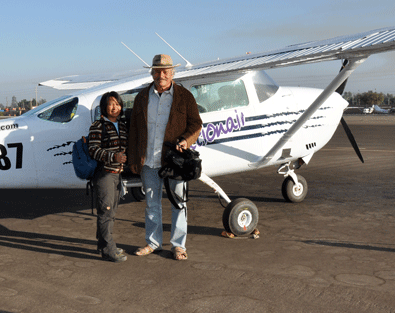

Yes, we dared to fly
she prayed all the time
The
plane overflew the area in 1000 m height
curved left and right, much to fast, it was
difficult to photo anything. However see
yourself
what we found.
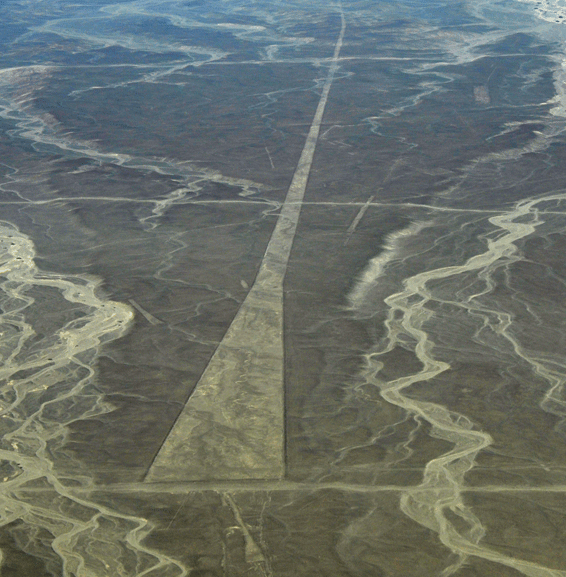
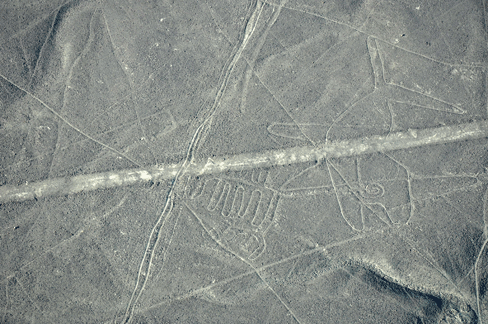
astonishing accurate over 3 km long
a whale figure over a straight line several
km long
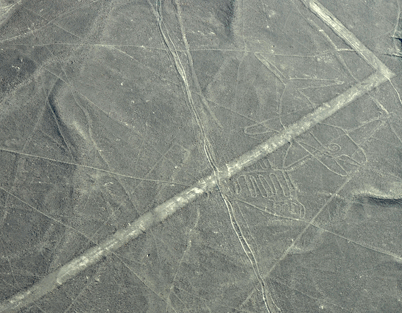
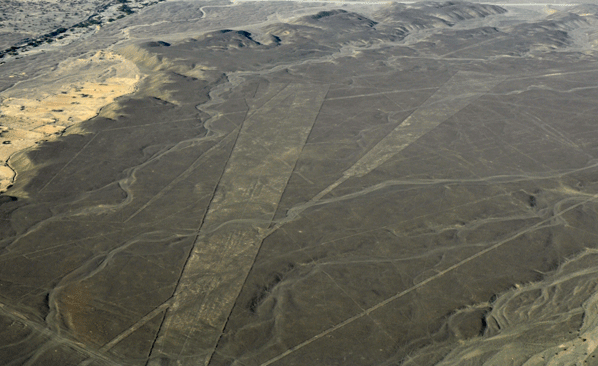
see the right
angle of the wide line? 3
km long;
what is this for?
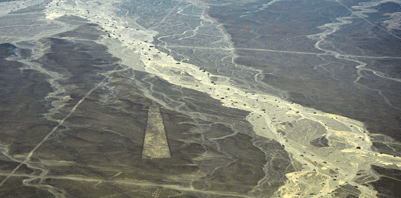
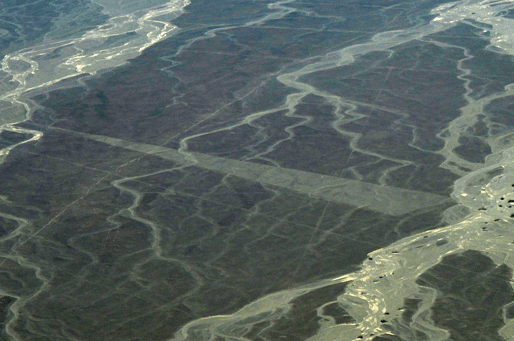
another "landing
strip?
and this one? 2 km
There are supposed to be over 300 drawings. Science do not know for
what purpose these were made. Maria Reiche investigated for
50 years. Measured and cataloged all drawings and came to the
conclusion; that the figures are in
connection with stars, Another
theory is, that these lines are direction indicators of underground
water flow. All is still a mystery. Erich
van Daeniken said, these have
been made by visitors from outer space, and for us, that is the most likely
theory.
See the birds, they are made over
the geometrical lines and fields. Could it be that locals made those, after
extraterrestrials visited
them; could they
have made the figures, to tell what can be found right here with them?
You may smile when we say
Extraterrestrials! But wait and read on.
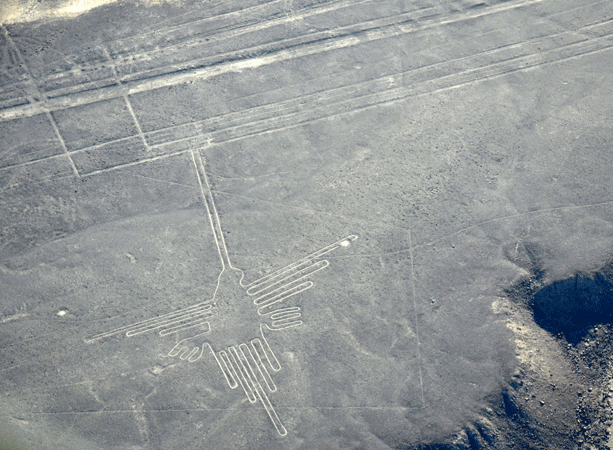

a "Hummingbird"
made by the locals?
see these cleared geometrical field and
lines
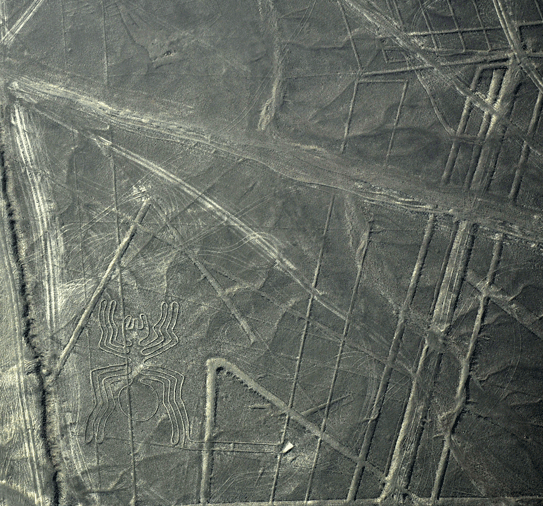
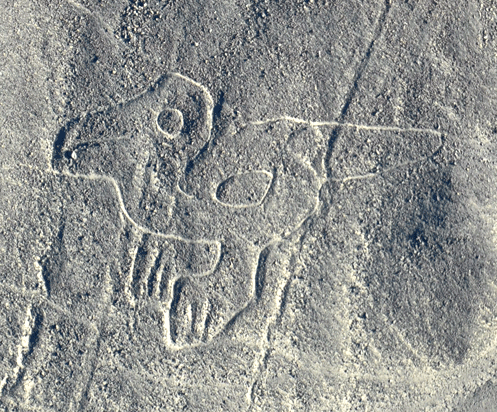
a spider
among the lines
a "parrot" on a mountain slope, at least 120m long
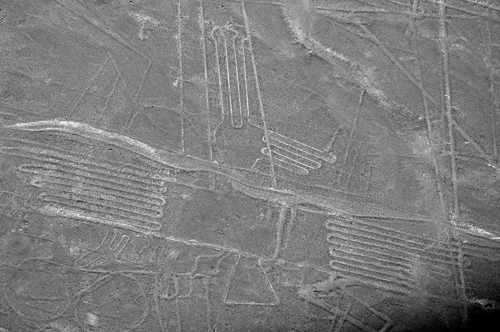

a
bird?
Dog 50 M high
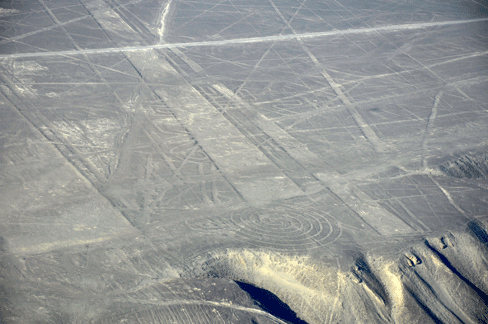
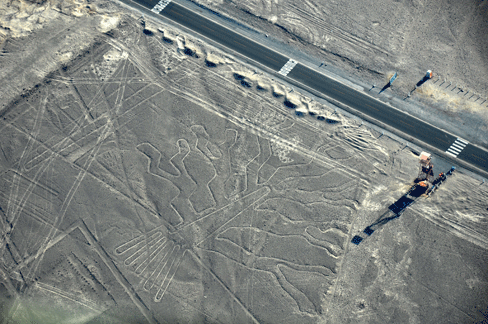
why two fields?
A mile long the road cuts through the area
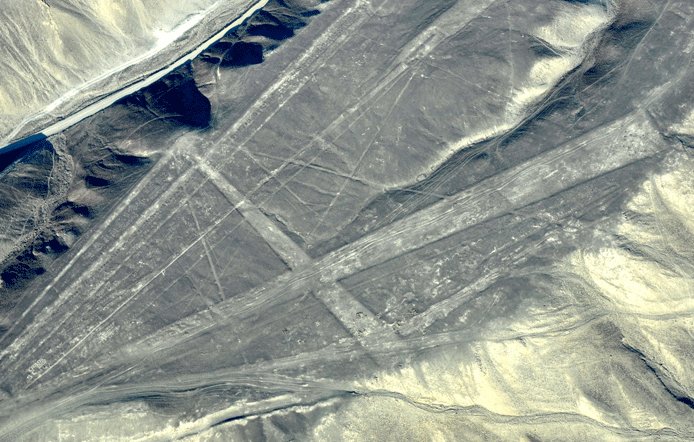
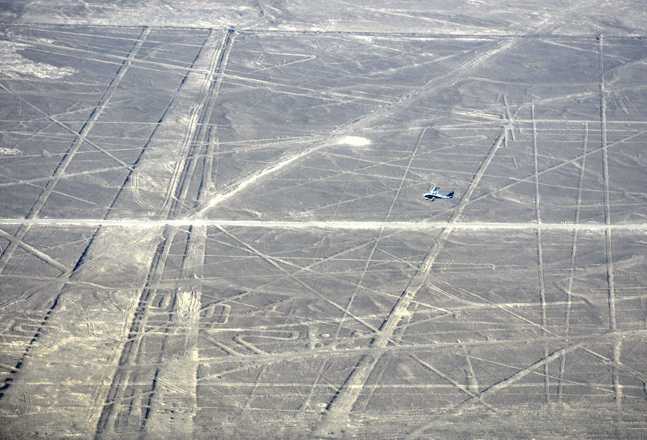
We are less interested in the figures, which are likely made in
their rude form by locals.
What we are more interested are the geometrical fields and lines
and that with good reason, because maybe, just maybe, we are no
lunatics, nor is there a screw
loose.
Let us look together at Mars and ESA the
European space agency. We look into one picture of a crater. The Hale crater. You can
follow
the steps we make and make your own
conclusion. You need an internet and "Photoshop" in your computer.
But first think. The spy satellites up in 400 km height can see
your breakfast bread, should you have it
outside in your garden. Ask
now why the sophisticated cameras orbiting mars, delivers smudged pictures? (blurred smooth).
Well, they are worked on afterwards
with software that mankind would not know what is actually
happening! But is ESA now purportedly
releasing these images?
This is an image of the Hale crater looking west. You find in the ESA Mars image files. Down load
the high resolution image from
ESA and crop the blue section out with Photoshop or any other
software. Then you play with contrast and filters, try it
out.

Hale crater looking West ESA high
resolution image
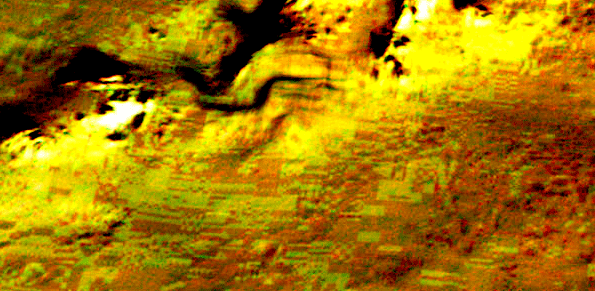
.
This is what I came up with. I used
Photoshop. These are no pixels. These are
buildings of some sort and fields.
U
shaped, rectangular, round and oval
structures. picture size is about 4-5 km. You
see the wheel with cross spokes?
In
front of you is evidence of intelligent life
on Mars.
Detailed instructions how you can penetrate
the blurring, you find in You tube,
;sean1david1ryan, mars
civilization evidence, Hale
crater.
I
go with the theory of Daeniken, that our planet is
frequently visited and perhaps alien live
here.
And Nazca was visited at their times too.
The extraterrestrials draw the geometrical lines for reasons
we do not know. The locals made the crude
drawings,
that the outer space visitors may know where
they are. Drawings are that big that they can only be noticed
from high altitude, that what the locals hoped for.
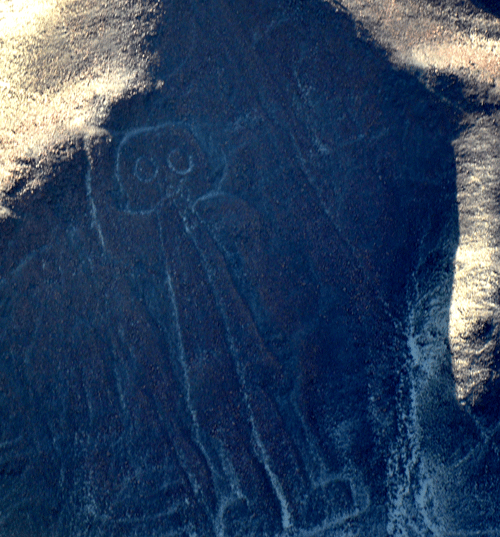
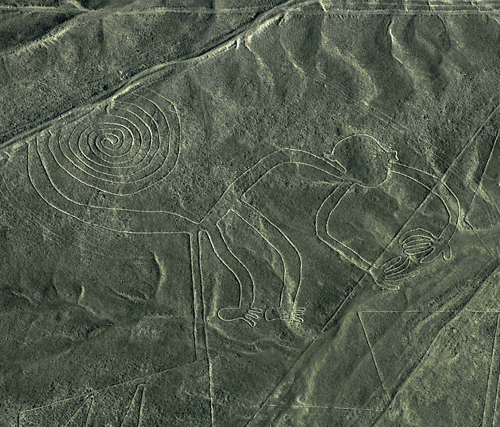
The
astronaut 300m tall made by locals
Monkey, size about 200
m
There are more confusing drawings along
Palpa, north of Nazca.
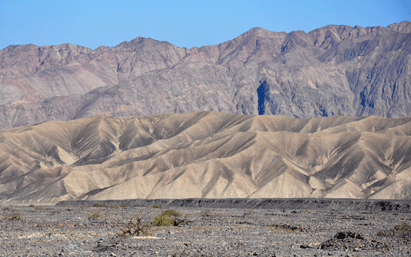
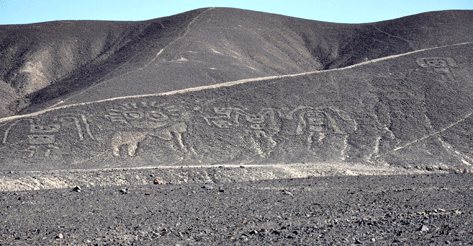
Mountains around Palpa
drawings on the slope
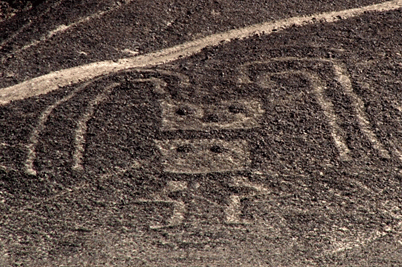
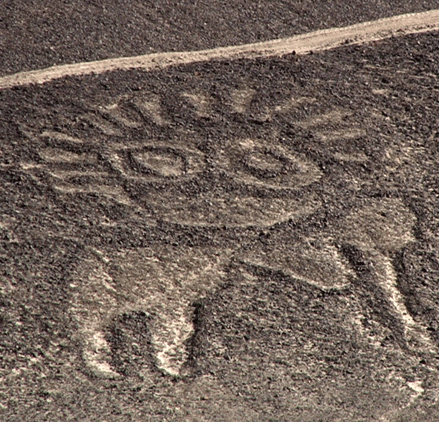
two figures, one with antennas?
13 radiation rays
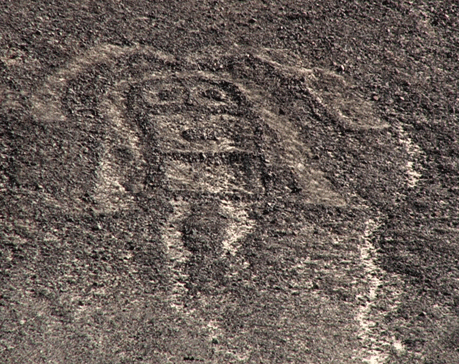
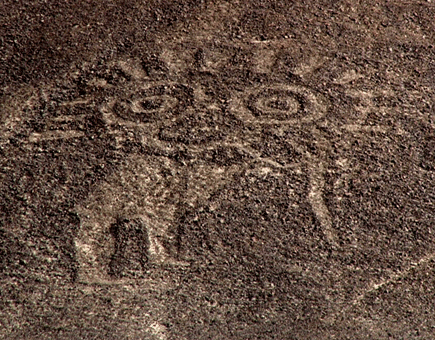
another strange figure
again big eyes; what is it to represent?
Interesting is it not? The
radiation rays on the figures with big eyes
are thirteen in number. Their size is about
6-8m.
20
km south of Nazca exist a Necropolis a 10
square km burial ground of a Nazca culture.
In these desert, littered with human
bones and pottery, are several open square or oval shaped
grave chambers containing mummies in fetus
position, facing east.
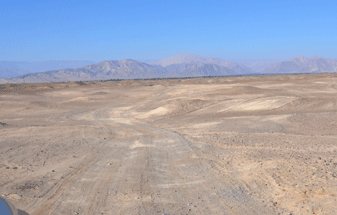
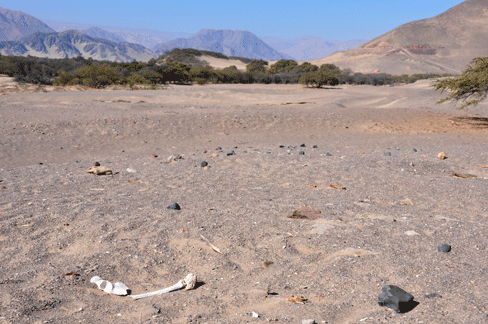
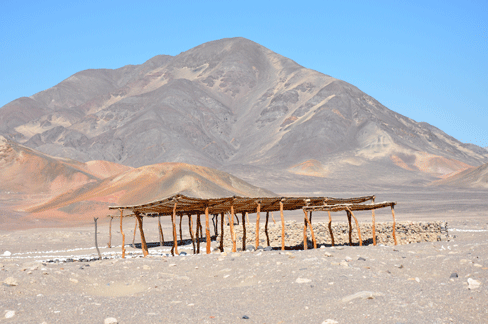
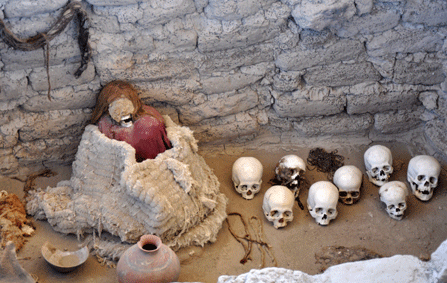
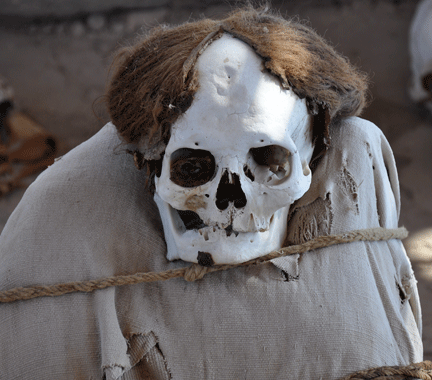
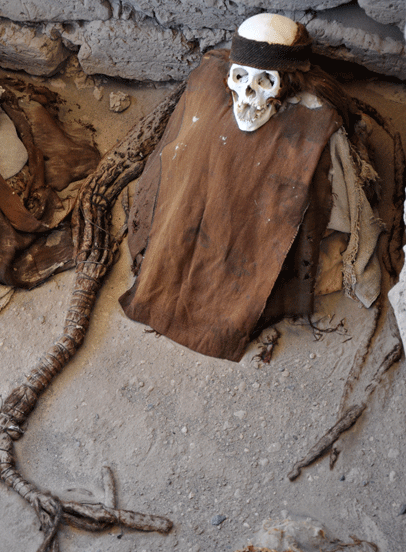
It is claimed that virgins had to shave
their heads and offer their hair. It was
woven into the hair of the celebrity corps
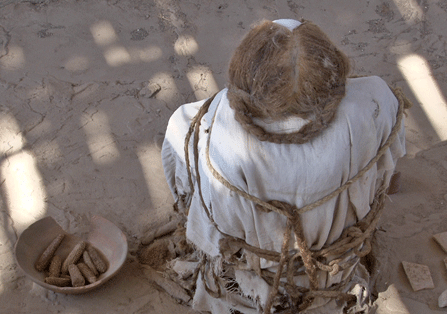

A
woman, 2000 years old
hair plaited buried and dig out again after 2000
years
The Nazca culture exist from 1100 B.C. to 750 A.D. The
society was made up of local chiefdoms.
Excavations gave evidence of
maize. bean and peanuts. Large amount of pottery was found.
There is the question of the Trophy heads
still open. Many burials
have been discovered in which the head of the skeleton was missing
and replaced with a head jar, a ceramic
vessel on which a
human head is pained on, along with plants and trees. They had no
writing system. The Nazca believed in
powerful nature spirits,
who control most aspects of life.
SATURDAY 3-7-2010
This morning we went to Cahuachi a place about 25 km in the desert.
There existed a nameless culture already
back to 4200 B.C,
But in 350 A.D. this temple center was sealed. People left and
never came back. No one knows why.
The burial procedures included slowly smoking of the corpses. Next
to the temple complex over an area of
maybe 1 square
kilometer, the graveyards. Many opened up by grave robbers, looking for
valuables and disturbing the peace.
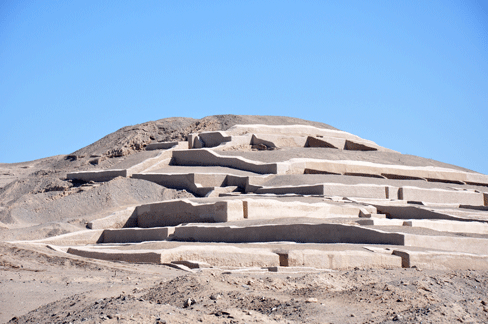
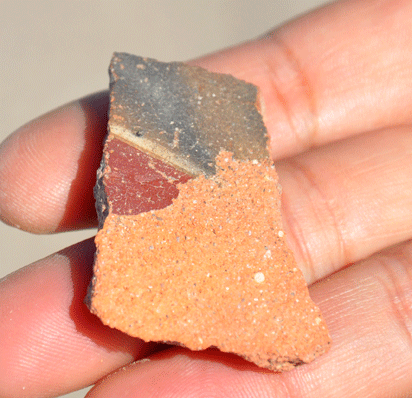
The temple pyramid of Cahuachi
glazed pottery
Bones are scattered around. One feels sad,
seeing how the peace has been disturbed and
remains are scattered..

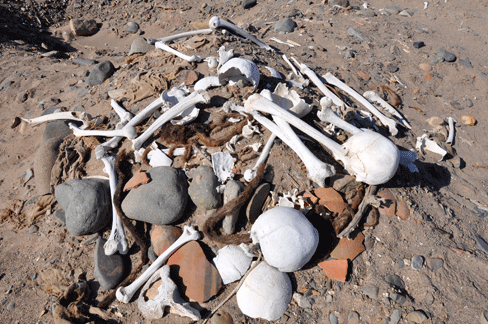
cloth and bones
three sculls, bones and pottery
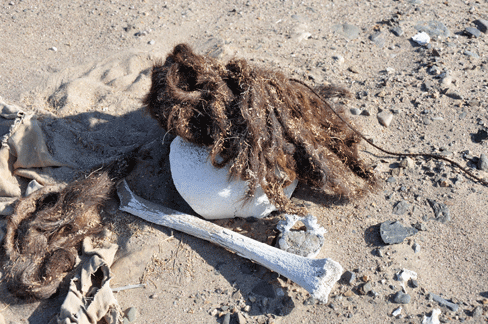

another grave
disturbed; scull and hair
see the small hills, everyone a search for a
grave
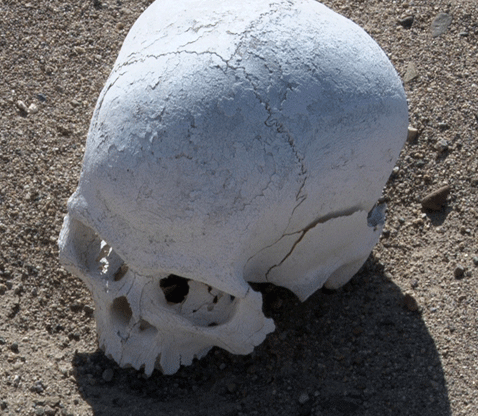
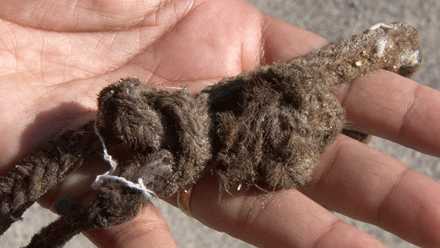
a scull lying
in the open
next by, some woven hair or a string
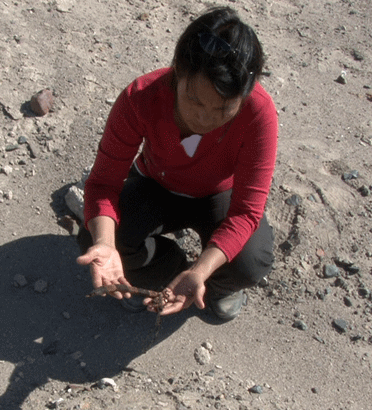
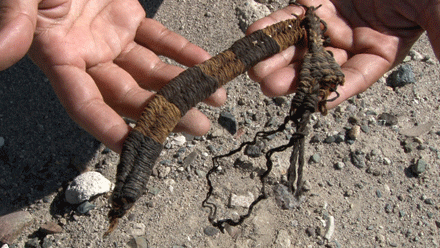
It was an uneasy and sad time there. it seemed the dead are present
and watch our actions. We did take nothing,
and moved out
from there, returning the desert track back to Nazca. Tomorrow
Sunday we leave heading north towards Lima.
SUNDAY 4-7-2010
We headed North towards Lima. The road was good, but heavy
traffic and construction work going on..
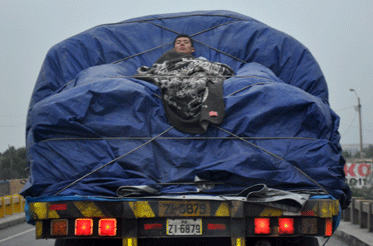
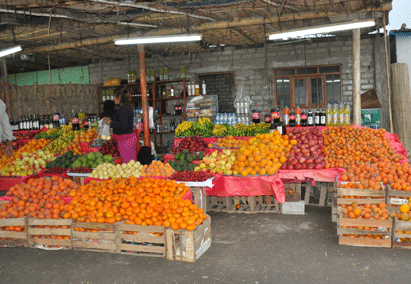
having a good rest
Fruit stall on the roadside
In Paracas we turned into the
the National park on the seaside. Desert
prevails here.
The water is very cold still and the swell breaking was
heavy. On rocks nest pelicans, seagulls
and cormorants.
Fish must be plentiful.
.
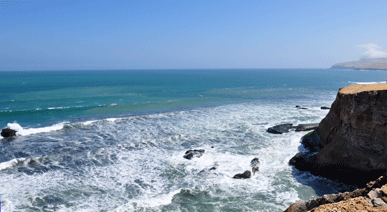
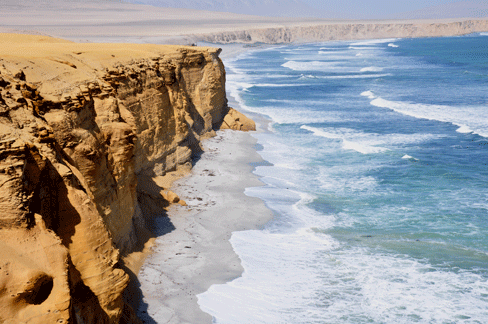
Bay of Paracas

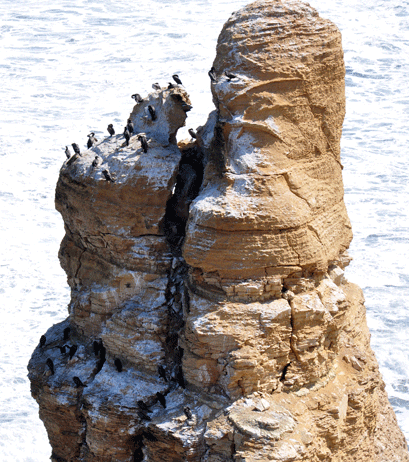
Zarcillos Birds (Larosterna inca)
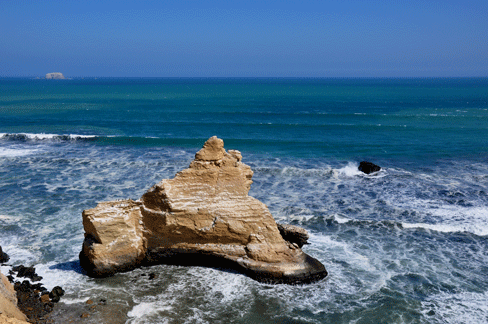
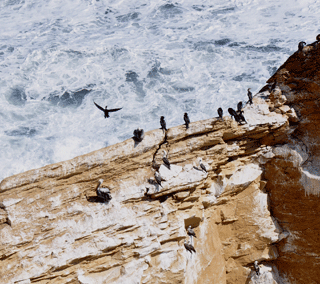
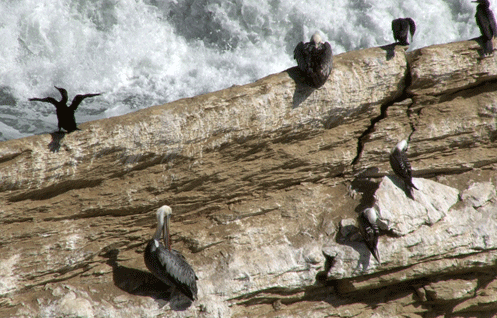
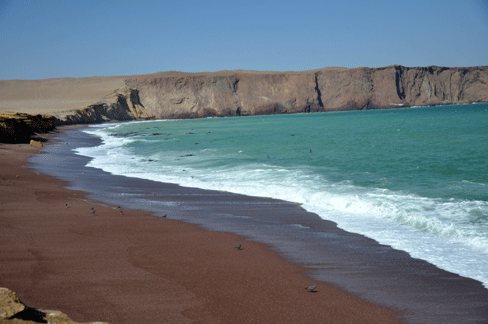
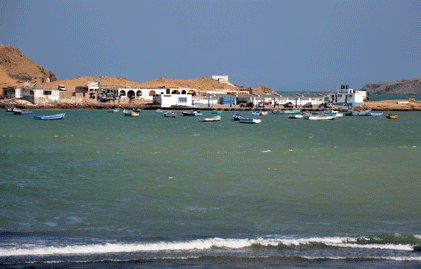
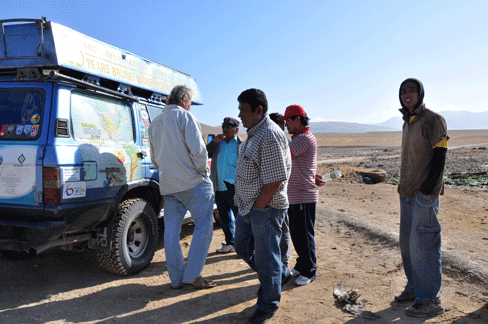
Fisher village in the cove
as everywhere people are curious and full of
admiration
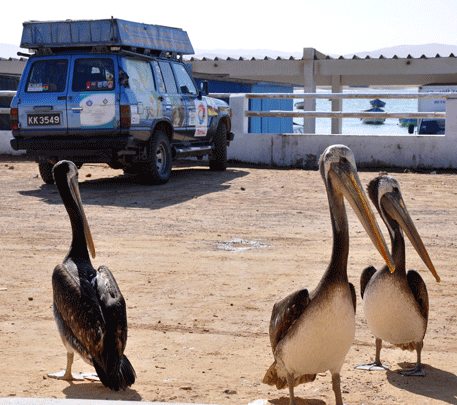
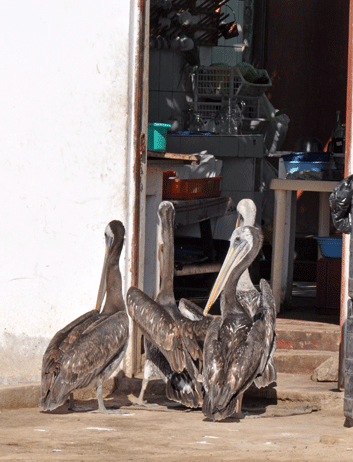
" check the blue car out Peli...
...while we go to the kitchen".
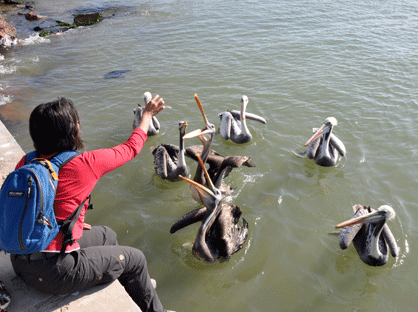
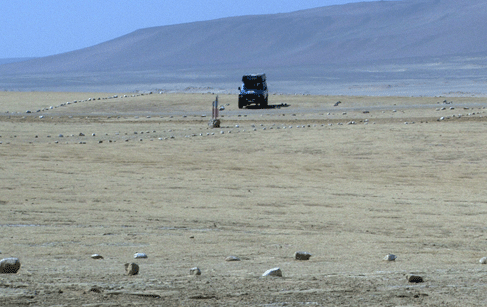
Feeding frenzy
patiently waiting
The
pelicans were lazy. Better waiting at the
kitchen door until some little fish comes
their way, or wait for a tourist who will
feed them.
Once Norhayati started to distribute food, they came from all
sides. Less than one hour later we were on
route again on the Autopista
Norte. In San Vicente we turned down to the beach for a deserved
sleep, after we had studied the maps.
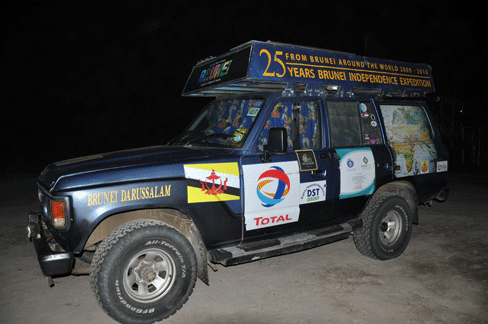
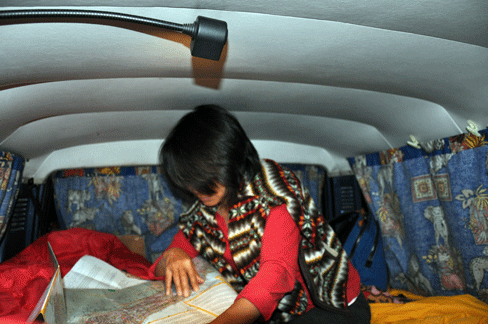
That is what
an outsider see of JAMBO
this is cozy inside just before sleeping
MONDAY 5-7-2010
We had about 260 km to Lima the capital. The traffic was
horrendous. At the Malaysian Embassy we
stopped for two reasons: one a
courtesy call, after all we are brothers in blood and religion. The
second is my passport.
Our Embassy in Berlin had send it to Lima. I was most grateful to
Pehin Yussuf our Ambassador in Berlin, one
of the finest gentlemen
around, and his staff, in particular Mr. Norazmi.
Not only did they organize my new passport, but send it to Mr.
Rosfan of the Malaysian Embassy here in
Lima.
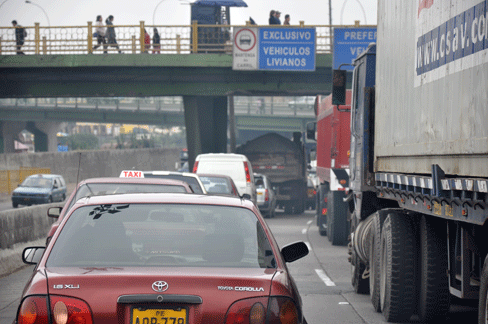
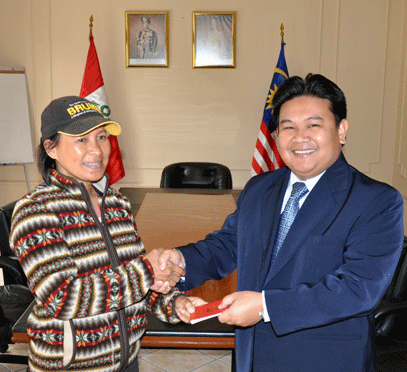
Terrible
traffic; for 1 km a half hour "Thank you Mr. Rosfan"
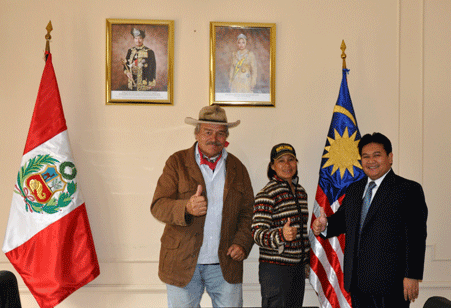 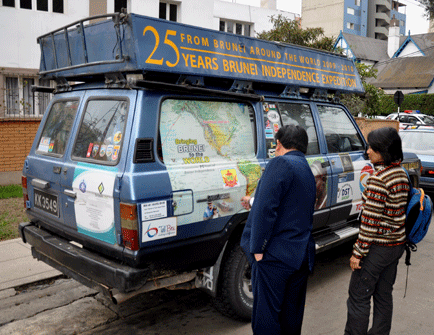
"Thumbs up"
"Brunei vehicle in Lima, that is something"
It was a memorable event. After a fine "cuchur udang", if
which only Malay (and Harun) know what fine
food that is, we moved on
and out of town towards Norte.
The police here had now stopped us four times. With all sorts of
argument. "Maybe...." . But we never paid
anything, it was just time
consuming.
Since Lima we had fog, it was unpleasant driving. The roadsides are
littered with rubbish and discarded construction material.
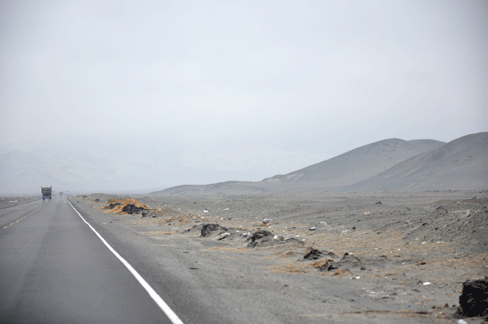

nothing to see except fog and lorries and
rubbish
By 8:00 pm we found a way to the shore down two km from the main
road. We did not see where we where, but
just stopped at the
shore and fell into sleep, while the incoming rollers were
pounding the gravel banks.
TUESDAY 6-7-2010
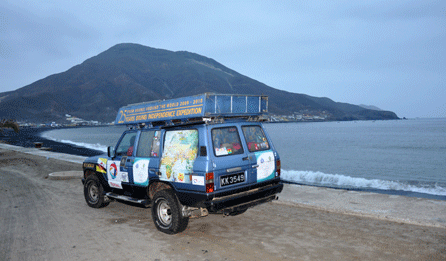
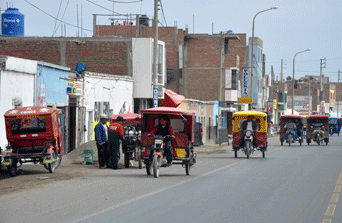
Where we stay last night
typical town scenes with taxies
645 km after Lima, the fog cleared and sunshine spread over
the land. By now it was late afternoon, and we searched for a hotel to
clean up and arrange our web
site.
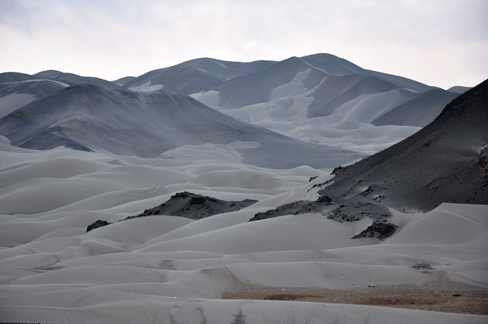
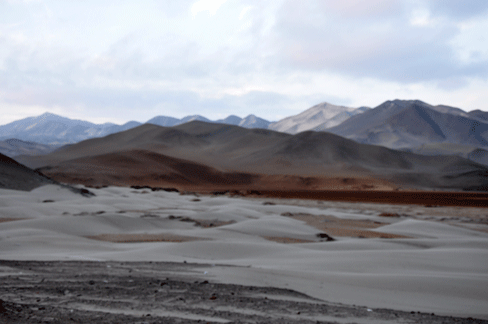
Beautiful sand formations
in the last light of the day
Sugarcane fields dominated now the landscape,
once awhile a tricycle, otherwise only
lorries on the road.

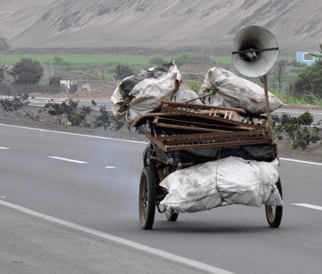
Sugarcane
the plastic collector with a self-made speaker
WEDNESDAY 7-7-2010
Today, we try to reach the
border of Ecuador, 700 km away. By evening
we arrived in a small village on the Pacific
shores.
Named Marcona Suddenly it was warm. No more pounding of heavy waves
on the shore. the beach was fine sand and-
plenty young
people from the USA and elsewhere around,. in swim dress or shorts.
We were out of the cold current flowing
along the coast
northwards.
"Everyday summer" said a signboard. We had come - unexpectedly-
across a kite surf "paradise", with all the
souvenir stands and
grills. Putting up in a cheap room for sanitary
installations, we slept in Hotel de la JAMBO.
Lots of fishing boats anchored, the sea
was calm.
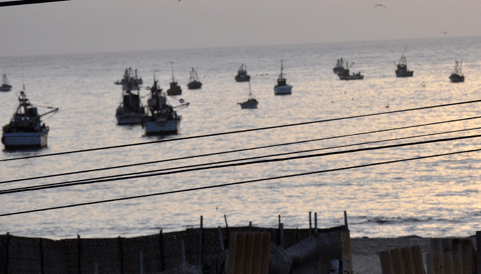

just put up your home on the beach
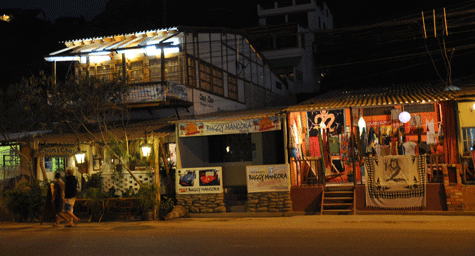
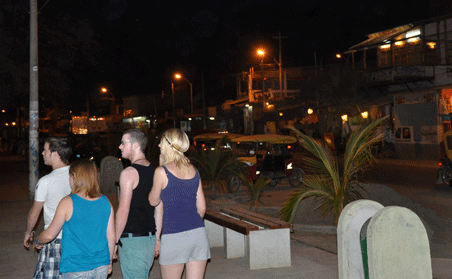
souvenir shops one after the other
strolling along, it is warm here
THURSDAY 8-7-2010
Already before 8:00 am we were on the way towards Ecuador and
reached the border by 11;30. the border
procedure took less than
one hour and we were on the way to GUYAQUIL the main port of
the country, there to check, how much it
would cost to ship JAMBO
from here to the nearest port in the USA. We had twice been warned
to stay out of several countries in Middle
America.
If you find the time follow us on this adventure by clicking
Ecuador.
|